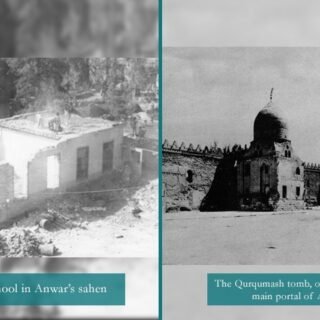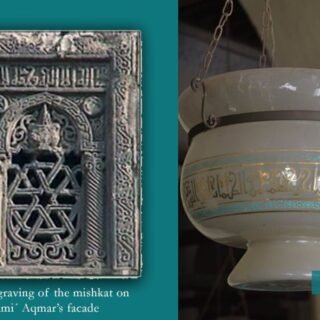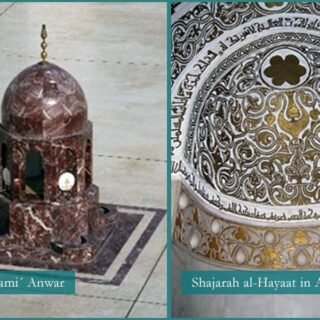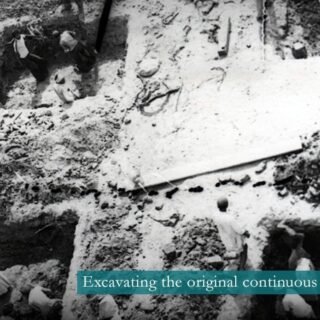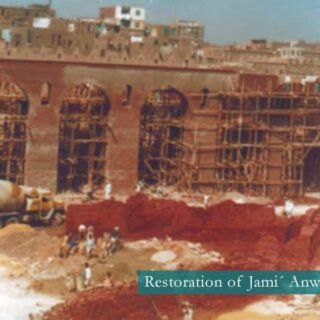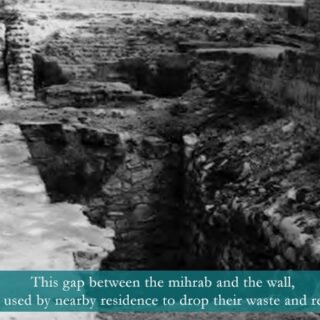One of the many glories of Prophet Mohammed SA is that he is the ‘gatherer of dispersed strengths’. This ability remains with Aimmat Tahereen AS, and in their seclusion, with Duat Mutlaqeen. Al-Dai al-Ajal Syedna Mohammed Burhanuddin RA revealed the very same glory when he assembled the lost pieces of Jami´ Anwar’s historical tablet:
In the name of Allah, the most gracious, the most merciful. “And we desired to bestow a favour upon those who were deemed weak in the land, and to make them the Imams, and to make them the inheritors (28:5)”. This is what Allah’s servant and chosen one, Abu Ali al-Mansur al-Imam al-Hakim Bi Amr Allah, the Commander of the Faithful – May Allah’s blessing be upon him and his pure ancestors – ordered to be done (constructed) in the month of Rajab of the year 393
The fifth aayat (auspice, miracle) of Anwar is the lawhat taarikhiyah (historical tablet). This unique stone inscription adorns the inner side of the masjid’s main entrance. The recovery of its scattered pieces, and its subsequent reassembly due to the blessed presence of Syedna Burhanuddin’s RA disproved allegations pertaining to Imam Hakim’s AS claims to divinity.
On 8th Moharrum 1401 H, in Jami´ Anwar, Syedna Burhanuddin RA stated ‘Nine months ago a piece of inscription was found. Upon it was written ‘م بامر’, with this discovery efforts to find the remaining pieces commenced. 118 years ago, the tablet was recorded to be in its original place, a traveler from Europe awed by the beauty of its script attempted to have it relocated to a museum in Europe. However, by 1880 AD, the tablet had broken into pieces, a priceless treasure was lost. During its restoration, six other pieces were gathered from various museums. Mamluk Aale Mohammed arrived in al-Qaaherah and another piece was found with ‘حيم ونريـ’ inscribed upon it. The حيم was identified as being from the bismillah, and the next part as the beginning of a Quranic aayat.
Al-Dai al-Ajal Syedna Aali Qadr Mufaddal Saifuddin TUS explained that the first piece found contained parts of Imam Hakim’s name –the م is from حاكم and بامر is from his honorific بامر الله . It was due to the barakat of the Imam’s name that the remaining pieces were found and the tablet put together. Further, ‘meem’ and ‘be’ are two letters with which we are all familiar with, for they comprise the tauqee mubarak (signature) of Syedna Burhanuddin RA. Many of us have araaiz which have been graced by this tauqee mubarak. The ‘م ب’ denote Mohammed Burhanuddin, and the remaining word ‘امر’ indicate that it was Imam’s amr (directive) to Syedna Burhanuddin RA to commence the revival and restoration of Jami´ Anwar.
Syedna al-Dai al-Ajal TUS commented that putting together the various pieces was no easy task. The difficulties involved in getting even the smallest of artefacts from a museum is well-known. However, Syedna Mohammed Burhanuddin RA was a divine magnet towards whom the relics of Aimmat Tahereen AS were drawn. Just as numerous manuscripts of Dawat kutub, many were autographs: in the handwriting of their authors, gathered in the library of Syedna Taher Saifuddin RA along with the coins and shawls of Aimmat Tahereen AS.
Gathering Mumineen
It was with the revival of Jami´ Anwar that the gathering of Mumineen began on an unprecedented scale. Rasulullah’s SA Dai, Syedna Burhanuddin RA, continued to gather Mumineen in his presence. Some came many times a year, even if there was no occasion. They were drawn to him in droves. Anwar’s inauguration was the first time that many Mumineen had travelled by plane. Others who did not possess the means, gathered funds from here and there and made the journey. This was all done to acquire the happiness and benedictions of Syedna Burhanuddin RA. Similarly, in 1411, when Asharah Mubarakah was held in Dar es Salaam, many Mumineen from Madagascar, who had not even left their respective towns and cities, made the journey to Dar es Salaam. At the zenith of all gatherings was the one that took place in 1435 H. As word spread of Syedna Mohammed Burhanuddin’s RA wafaat, Mumineen from all over the world dropped everything and made their way to Mumbai to be a part of the janazah mubaraakah. Syedna al-Dai al-Ajal TUS stated that gathering in this manner is not something to be belittled or consider trivial.
The act of gathering is a key element in the functioning of this world. For example, if one was to trace the origins of the foods he consumes he will realize that it comes from various locations. These dispersed elements all come together in one’s body, yet the ability to bring together these scattered elements is divine and only possessed by Imam al-Zaman AS and his Dai TUS.
The Art of Writing
The gathering of the fragments of the lawhat, and the joining of letters in writing are works of skill. Writing involves the gathering of alphabets to form words. The writer who skillfully conjoins letters is known as a calligrapher. Amirul Mumineen AS explained to his calligrapher Abdullah b. Abi Raafe´ the prerequisites of graceful handwriting which included taking care of the inkwell, pen, joining letters and maintaining proper spacing between words.
Maula alone is truly able to gather and bring us together in a coherent whole. While others in this world attempt to form and maintain a union, they are prone to failure with someone eventually seeking to exit the setup. By Allah’s will, Maula gathers disparate entities which were strewn far and wide when the fall from grace took place. This majlis is an example in which Maula gathers Mumineen of varying temperaments. One may be sitting next to an individual who may be of a completely different nature to him/her, however, the overarching mohabbat for Imam Husain AS brings and keeps everyone together.
The juxtaposition of writing skill and gathering is beautifully demonstrated in the narrative of Maulatona Fatema’s AS pearl necklace. The young Imam Hasan and Imam Husain AS attempted to wrestle each other in order to establish which of them was stronger. They came before Rasulullah SA and asked him to judge between them. He replied that such acts do not behoove us, and instead asked them to write a sentence each. When they did, Rasulullah SA sent them to Amirul Mumineen AS since he did not wish to upset one by favouring the other. With the same intention in mind, Amirul Mumineen AS in turn, sent them both to Maulatona Fatema AS. Her solution was to scatter her necklace containing seven pearls, the one who gathers more pearls will be deemed the stronger. Each of them managed to gather three pearls and were looking for the fourth one, however, at the same time each intended for the other brother to gather that elusive pearl. This wish of theirs came to fruition when Jibraeel descended and made two pearls out of the remaining one. Syedna al-Dai al-Ajal TUS cast a new light upon this incident when he told us that the strength Rasulullah SA wanted to see was their strength in gathering together far flung souls and bringing them all together, just as they had brought together alphabets into words.
Likewise, Aimmat Tahereen AS counseled the Duat of their times to bring together their followers. Following, their seclusion, Duat Mutlaqeen RA continued to gather Mumineen, and to that end were prepared to do all that was necessary. Even when circumstances are adverse, they will nevertheless avail each and every opportunity to bring together Mumineen.
It is well-known that the sons of Adamjee Peerbhoy were deeply embittered towards dawat and dai, but they also maintained a high-profile within the community. The Chelum of Imam Husain AS was one occasion during which they hosted a niyaaz for which Syedna would always grace them, even if it meant traveling to Mumbai for the occasion. One year, however, the sons demanded that no invitation be sent to Syedna Mohammed Burhanuddin RA (49th Dai Mutlaq) who was in Surat at the time. As the date drew near and the news of this misdeed spread, the faithful made it clear that since Syedna was deliberately not invited, they too would stay away. Faced with public humiliation, a telegram was sent to Syedna requesting him to attend. Despite the last-minute invitation, Syedna set out taking the night train to Mumbai. Even then there was friction in the family since Adamji observed the required etiquettes for qadambosi even though his sons had ordered him not to. The argument continued for over ten minutes, with Syedna hearing every word of this vociferous feud. The sons were rebuking their father, while the father continued reminding his sons of Syedna’s benevolence for gracing them with his presence. The ill feelings festered, however, and Syedna departed from Mumbai where he stayed at Adamji’s residence after just ten days – much shorter than usual.
Adamji’s residence in Mumbai was frequented by Duaat Mutlaqeen, and was a place where they found solace. On one occasion, the young Syedna Taher Saifuddin RA was seated on the verandah practicing his handwriting in a book. Following a sabaq, Syedna Mohammed Burhanuddin RA came to him and asked him what he was doing. Syedna Burhanuddin RA took the book and wrote the verse ‘And soon Allah will suffice, and He is the all-hearing, all-knowing’. In 1341 H, it was this very bungalow that Syedna Taher Saifuddin RA purchased covertly without the sons of Adamji knowing until the time of documentation. Syedna Taher Saifuddin RA relates that even as they ascended Malabar Hill he was still uncertain as to which bungalow was purchased, but finally when they turned in from Jinnah’s bungalow he was certain that the bungalow he wanted to acquire – where Syedna Burhanuddin had written the aayat for him, all those years ago – had in fact been purchased.
The knowledge of how to gather Mumineen was also in the possession of hudood fodalaa’. During the time of Jafar’s fitnat, Maulaya Raj QR brought Mumineen to the fold of Dawat by visiting their homes garbed in the clothes of a beggar and gently counseled them. When the Jafaris and Hashawis came to know of his efforts in gathering Mumineen, they cut him into pieces. His qabr mubarak is in Ahmedabad surrounded by the graves of 125 other shohadaa’.
Syedna al-Dai al-Ajal TUS also counseled Mumineen and Muminaat to lead their lives in a manner that ensures that they remain with Maula in this world and the next. He stressed that one must pray all five faridat namaaz on time, eat a hearty breakfast, persevere in seeking a livelihood, sit at a thaal for dinner, spend time with their family and at the end of the day take account of the day’s activities. If they have wronged anyone then they should seek forgiveness from him/her. Likewise, so that one remains safe from the gaze of those with ill-intent, he should recite Quran Majeed, as well as other duaa’s like al-Nasr wa al-Mahaabah, Duaa’ al-Kaamil – to be prayed at least once a day – and Duaa’ Joshan. He also made it clear that Satan will surely enter the homes in which songs are played. He addressed those women who felt that this modern age requires that they attire themselves in a manner that is more becoming of it. He responded to those who question ‘why are you asking us to maintain purdah’, by stating that the mohabbat of Maulatona Fatema AS requires Muminaat to maintain their purdah. We are Dawoodi Bohras. For us, beauty is the inner one.
The expression of noh and aweel is the key to gather the scattered entities that were once a whole. Noh means to come together and cry. Another meaning is for the soul, body and all the organs to come together and be unified in their grief and lament upon Imam Husain AS. The remembrance of Imam Husain AS has greatly increased our strength: as individuals and as a community. We should remember that in the moments leading to his shahaadat, Imam Husain AS addressed the various parts of his body. He counseled his heart to bear these hardships, his feet to persevere in Allah’s cause, his raas mubarak to offer gratitude to Allah even when raised atop the spear, and for his body to praise Allah despite being soaked in its own blood. May we too counsel each part of our body, our family members, our loves ones and brethren in faith to expend ourselves in actions that bring us all closer to Maula and, eventually, allow us to gather in his presence.

